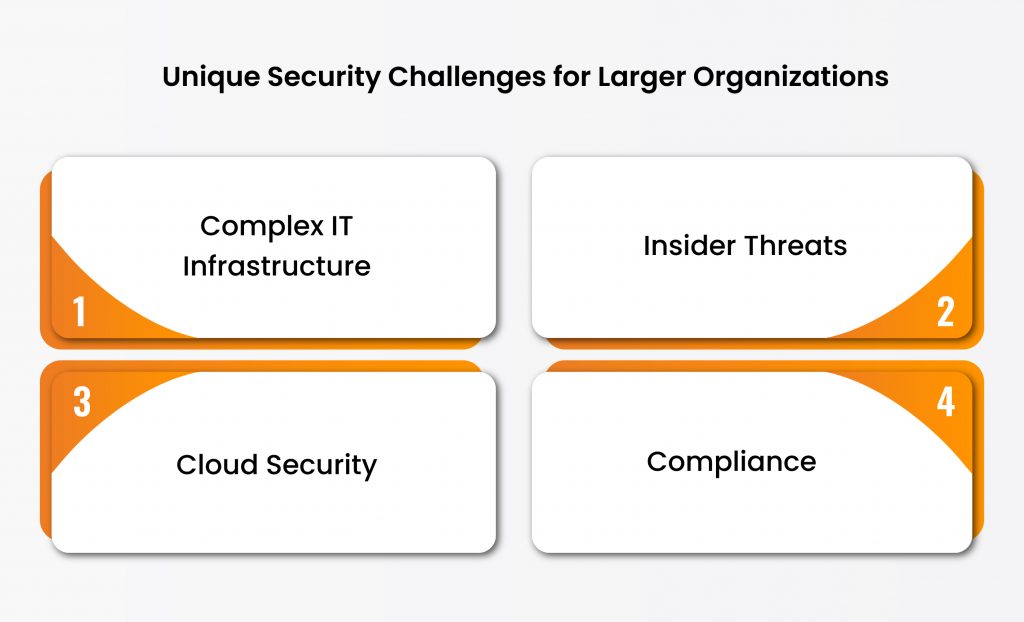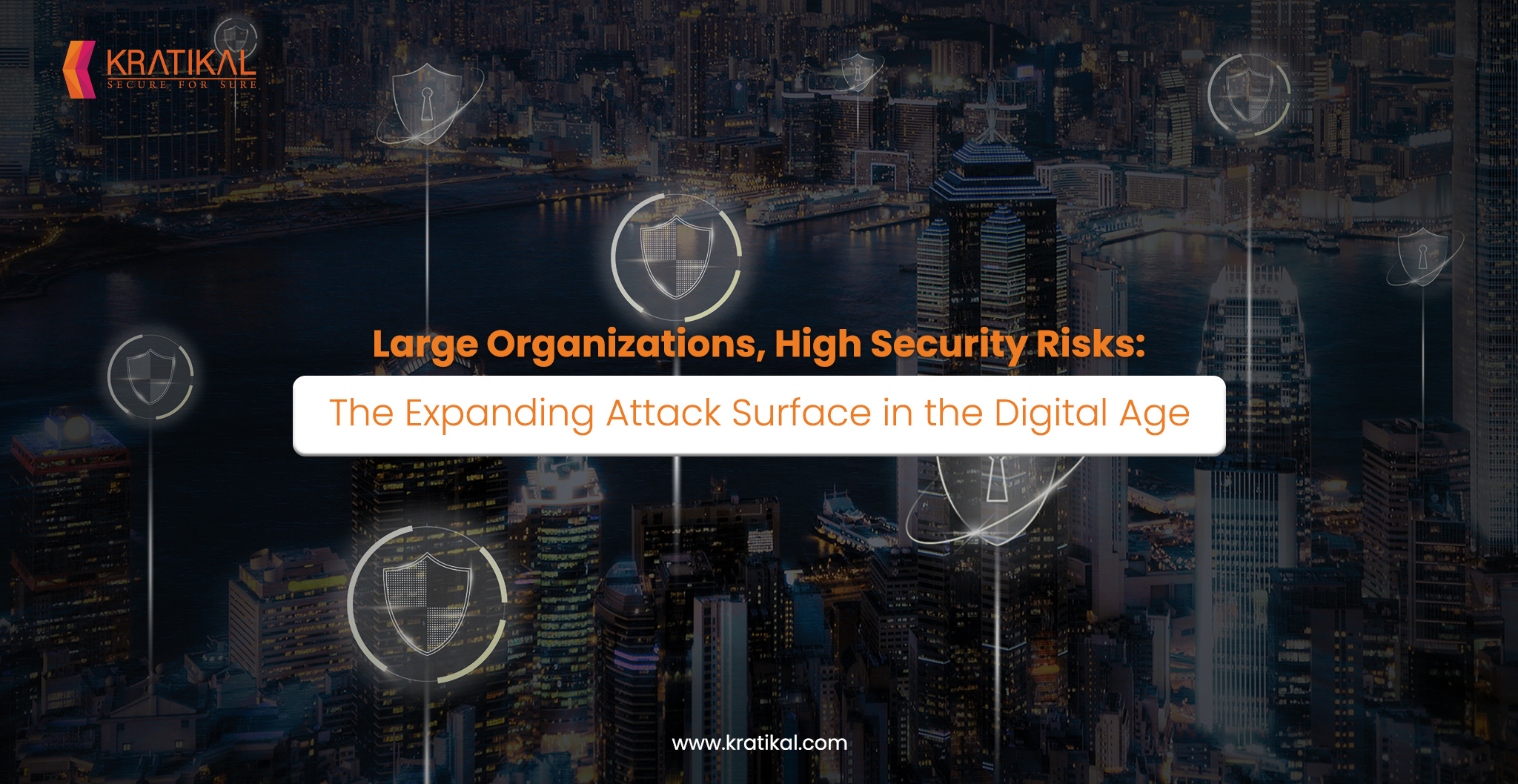“The larger the organization, the more complex and diverse its attack surface becomes, requiring a comprehensive and proactive security strategy to mitigate the risks.”
In the current digital era, businesses of all kinds must contend with an expanding variety of cyber risks. Larger organizations, on the other hand, frequently have a wider attack surface, which means more potential weaknesses could be exploited by malicious actors. This is due to the fact that larger firms frequently have more complicated IT infrastructures, a greater number of personnel and devices, and a greater amount of sensitive data that needs to be protected.
Therefore, having strong security measures in place to guard against cyberattacks is essential for large enterprises. Strong access controls, routine software and security patch updates, regular security audits and vulnerability assessments, as well as thorough employee training to prevent social engineering attempts, are some examples of what is involved in this.
In this article, we will delve more into the particular security threats that larger businesses face and examine techniques that can be used to reduce those dangers. As cyber threats change, we’ll also talk about some of the most recent trends and best practices in enterprise security to help businesses stay ahead of the curve.
One of the most recent instances of a vulnerability affecting huge corporations was the following: “The agency (CERT-In) has uncovered vulnerabilities on Mac PCs, Watches, and Apple TVs that, if abused, may provide the attacker with “access to sensitive information.” Users are advised to upgrade their software versions right away by the department inside the Ministry of Electronics and Information Technologies (MeitY). (https://www.indiatoday.in/technology/news/story/indian-govt-issues-high-security-warning-apple-macs-watch-users-update-immediately-2355169-2023-04-03)
Table of Contents
Get in!
Join our weekly newsletter and stay updated
Unique Security Challenges for Larger Organizations
Organizations are dealing with an expanding number of security concerns as technology develops further. Due to the sheer amount of data they keep and the complexity of their IT systems, larger enterprises are particularly susceptible to cyber-attacks and security breaches. In this blog article, we will examine the particular security concerns that larger enterprises confront and talk about risk-mitigation techniques.
- Complex IT Infrastructure – Many networks, devices, and applications are frequently present in larger enterprises, and they must be managed and secured. It might be difficult to make sure that all devices and applications are up-to-date with the most recent security updates and configurations because so many employees have access to these resources.
- Insider Threats – Employees of larger companies frequently have access to confidential information and systems. As a result, hackers may target them in an effort to take advantage of their access to resources used by the business. Moreover, displeased workers may purposefully harm business systems, steal information, or sell critical data to outsiders.
- Cloud Security – For data storage and application operation, many larger organizations are implementing cloud technologies. Cloud environments must be protected against threats like data breaches, loss, and unauthorized access as a result of this adoption, though.
- Compliance – Many different compliance regulations, including HIPAA, PCI-DSS, and GDPR, frequently apply to larger firms. Fulfilling these criteria can be very difficult, especially if you have to follow several compliance frameworks.

Strategies for Mitigating Security Risks
It can be difficult to mitigate security threats in a large business, but there are a number of strategies that can assist in shrinking the attack surface and improving overall security. Some effective methods are listed below:
- Security Awareness Training – Regularly giving all staff security awareness training is one of the best strategies to reduce security concerns. Password security, phishing scams, and social engineering should all be included in this training.
- Access Control – Insider attacks can be avoided by restricting access to critical information and systems. This can be achieved by putting robust access restrictions in place, including role-based access control (RBAC), and by keeping an eye on user activities.
- Regular Patching and Updates – It is possible to safeguard systems, programs, and devices from the most recent security risks by routinely updating and patching them. The management of updates and patches should be the responsibility of a separate team in larger enterprises.
- Cloud Security – Cloud environments can be made safer by implementing security mechanisms like encryption, access limits, and multi-factor authentication. Also, businesses should evaluate and tweak their cloud security posture on a regular basis.
- Perform regular security audits: Regular security audits are a good way to find potential security flaws. These can include compliance audits, vulnerability assessments, and penetration testing.
- Install monitoring and detection systems: Security monitoring and detection systems can aid in prompt detection and response to security events. Tools like endpoint detection and response (EDR) systems, security information and event management (SIEM) systems, and intrusion detection systems might be included in this.
Get in!
Join our weekly newsletter and stay updated
Conclusion
Larger attack surfaces are frequently found in large organizations, which increases the number of potential points of entry available to attackers. Attackers can employ a range of methods, such as physical breaches, phishing scams, and software exploits, to acquire confidential data or disrupt operations.
In addition, it may be difficult to verify that uniform security measures are in place in large enterprises because they frequently need to secure numerous complex networks and systems. More importantly, it is critical to have strong security rules and training programs since personnel in larger firms may be more vulnerable to insider threats or social engineering attacks.
In order to address any weaknesses or new threats, it is crucial for large businesses to put in place comprehensive security measures and to periodically analyze and upgrade their security posture. Putting in place firewalls, intrusion detection and prevention systems, access controls, data encryption, and routine security audits and testing are some examples of this. Continual employee training and education can also help to raise security knowledge and compliance while lowering the possibility of human mistakes.
With an emphasis on providing specialized and affordable solutions, Kratikal, a cert-in empanelled organization, can assist companies of all sizes and across a range of industries in strengthening their cybersecurity posture and safeguarding their priceless data and assets.
Is your organization’s security up to par with its size? With a larger attack surface, big companies face even bigger security risks. How are you mitigating these risks? Share your thoughts in the comments below !!









Leave a comment
Your email address will not be published. Required fields are marked *